Belgium has long been regarded as one of the best teams in Europe but they are yet to achieve any glory in major competitions. At the last Euros in 2016, they were surprisingly knocked out by Wales in the quarter-finals, despite having the likes of Eden Hazard, Romelu Lukaku, and Kevin De Bruyne, to name just three standout players, in their starting XI. Marc Wilmots was soon replaced by Roberto Martinez, who led Belgium to the semi-finals of the 2018 World Cup, where they lost to eventual winners France. Belgium have also risen to the top of the FIFA World Rankings under the Spaniard, and have been extremely consistent, losing just twice in 27 matches since the World Cup. This tournament is probably the last chance for Belgium’s own ‘Golden Generation’ to claim a major trophy, with the likes of Thibaut Courtois, Toby Alderweireld, Thomas Meunier, Axel Witsel, De Bruyne, Hazard, and Lukaku all nearing or past the age of 30 already.
THE SQUAD
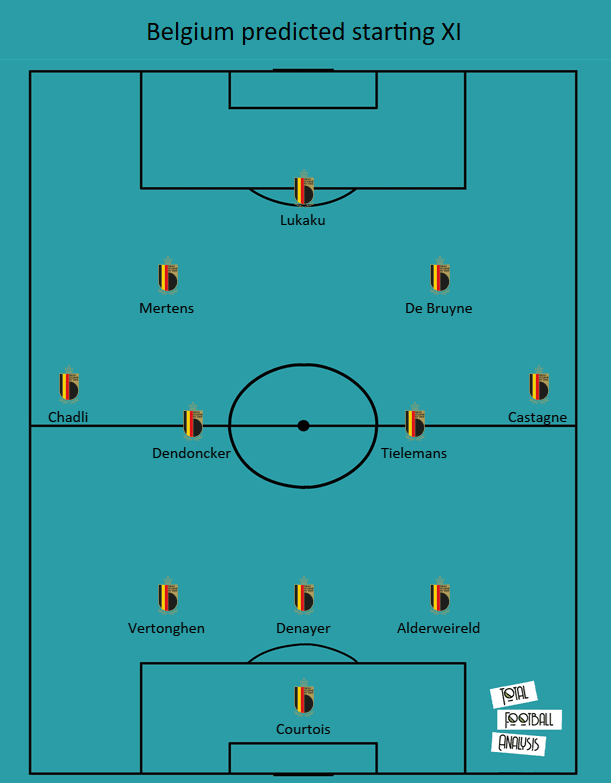
Martinez has displayed a clear philosophy and style of play during his time in charge of the Red Devils, and this enables us to predict his starting XI with some certainty. Belgium will line up in a 3-4-2-1 shape, which allows Martinez to account for the lack of quality Belgian full-backs by using wing-backs, and this also means that he is able to play most of his best creative and attacking players.
Courtois is the undisputed starting goalkeeper, having completed another strong season at Real Madrid, with Simon Mignolet and Matz Sels as his backups. In defence, Alderweireld and Jan Vertonghen have had a good understanding for both the national side as well as their time together at Tottenham Hotspur, and this duo will be accompanied by Jason Denayer of Olympique Lyon. Thomas Vermaelen is 35 now and not good enough to start, while Dedryck Boyata has had an injury-plagued season for Hertha Berlin.
Axel Witsel suffered an injury to his Achilles in January, undergoing surgery and therefore putting his participation at these Euros in doubt. Martinez has included him in the 26-man squad, but it remains to be seen if the Borussia Dortmund midfielder will be fit enough to start for Belgium. We expect the Premier League pair of Leander Dendoncker and Youri Tielemans to form Belgium’s midfield pivot in Witsel’s absence, with Dennis Praet and Hans Vanaken as the backup options.
Belgium have long had issues with producing quality full-backs, so much so that they have often had to use the likes of Alderweireld, Vertonghen, and Vermaelen as auxiliary full-backs in previous years. Under Martinez, however, the Red Devils have usually been set up with a back three and wing-backs, which mitigates this lack of quality. The Spaniard has also used wingers in these roles to further emphasize Belgium’s attacking threat, and that is set to continue at this tournament. Atletico Madrid’s Yannick Carrasco should start on the left, after an excellent season that has seen him win La Liga while playing in that position, with Leicester City’s Timothy Castagne expected to play on the opposite flank. Castagne can shift across to play on the left as well, while Nacer Chadli and Thorgan Hazard offer further options in this area of the pitch.
Hazard, De Bruyne, and Lukaku will form one of the most dangerous attacks in the tournament, even with Hazard’s lack of form and fitness. Lukaku has had a superb season leading the line for Serie A winners Inter Milan, scoring 24 goals and setting up a further 11, while De Bruyne chipped in with six goals and 12 assists for Manchester City in the league. While Hazard may have struggled for Real Madrid, there is no doubt about his quality, and the squad has capable understudies in the likes of Dries Mertens, Leandro Trossard, Jeremy Doku, Christian Benteke, and Michy Batshuayi
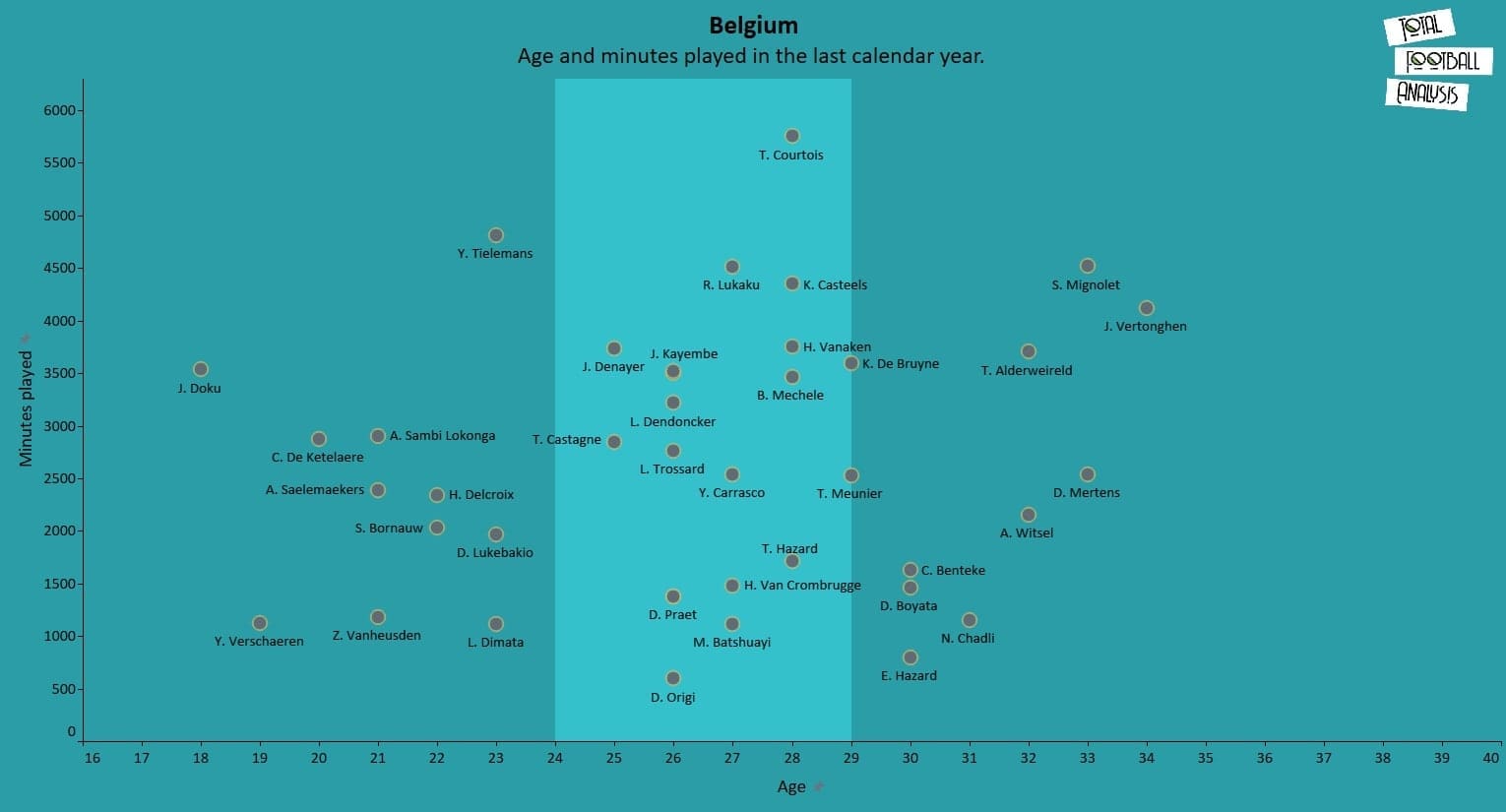
The age distribution shows a healthy mix between youth and experience, with Belgium’s most important players in their peak years. The likes of Mertens, Vertonghen, and Alderweireld form an experienced core that has also featured enough in the last year to be able to step up when needed, while the only ‘young’ player who is expected to regularly feature in the XI is Tielemans. However, even he is an experienced player at the top level, having already picked up 37 caps for Belgium to go with his crucial role for Leicester City in the Premier League over the last couple of seasons. Thus, Belgium have a very experienced and talented squad that should have the mentality to be able to deal with the vagaries and circumstances of tournament football in a good manner, as they showed in Russia three years ago as well.
ATTACKING PHASE
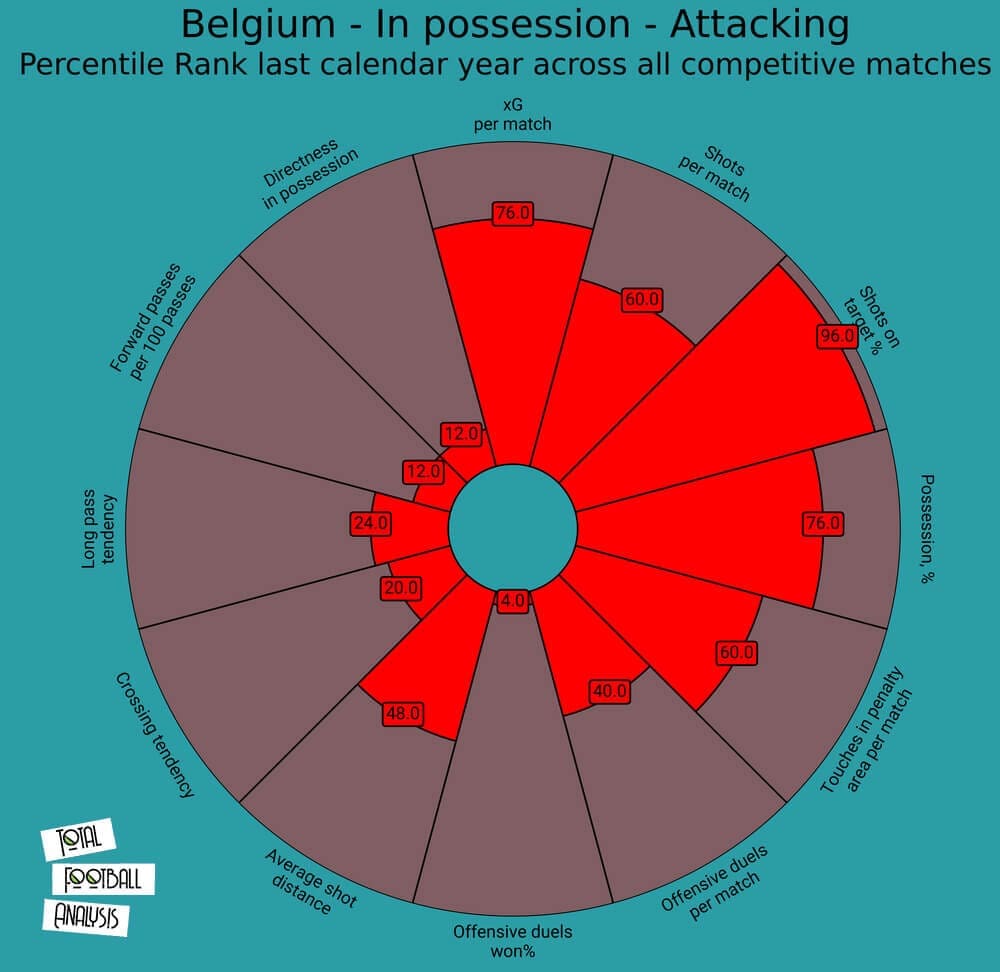
Martinez has been heavily influenced by Barcelona and Pep Guardiola’s style of football, so it is no surprise to see Belgium ranking high for possession (76) over the last calendar year, as they look to dominate on the ball. This is further emphasized by their percentiles for forward passes per 100 passes (12), long pass tendency (24), directness in possession (12), and crossing tendency (20) – all of which point towards a patient style of play. They have also been able to translate this possession into an attacking threat, as the percentiles for xG per match (76) and shots on target % (96) show.
A few in-game examples are included in this tactical analysis, it helps us understand Belgium’s tactics in possession in a little more detail.
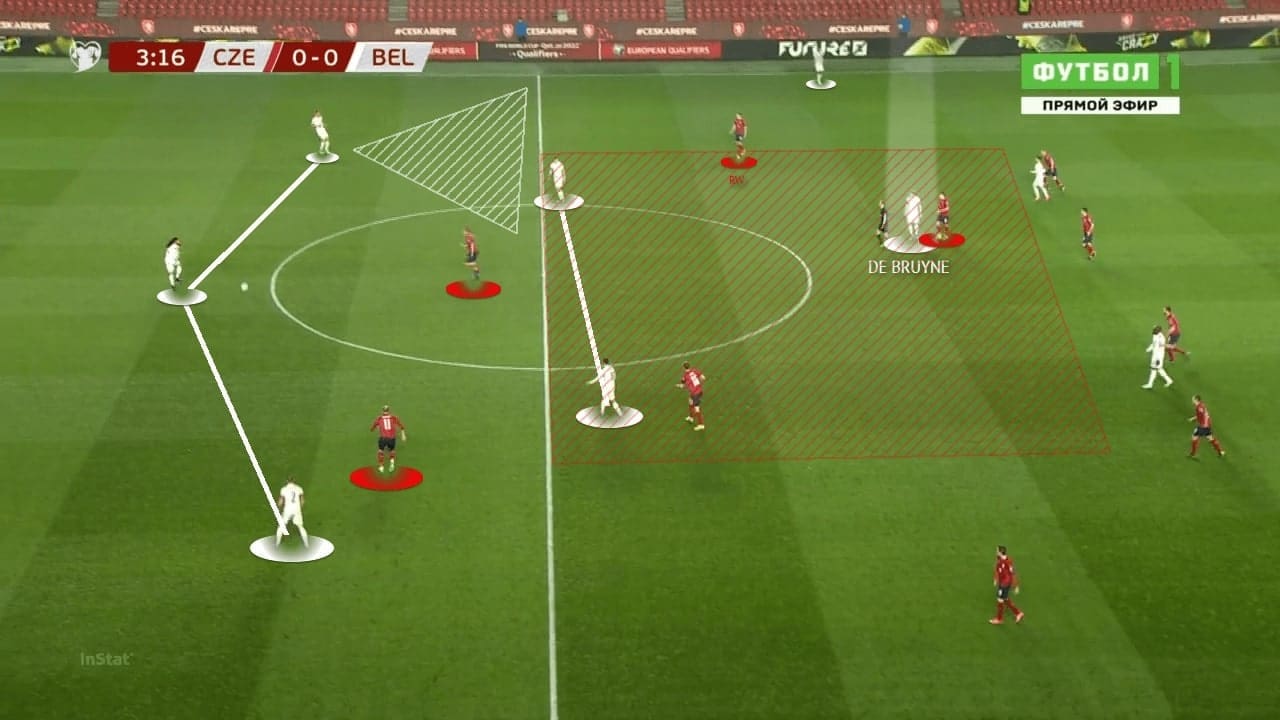
Playing with a back three means that Belgium are usually able to have numerical superiority when building up from the back, as opponents will usually have one or at most two players in their attacking line. This helps them play out of the back easily, especially with the likes of Alderweireld and Vertonghen who are very good on the ball. We can see this sort of situation in the image, where Vertonghen is the free man in the build-up.
The second line will usually consist of the two players in the double pivot, who will rarely look to drop into the defensive line. Rather, they will try and stay behind the opposition strikers to try and attract the opposition midfielders, as this will create space for the likes of De Bruyne and Hazard in front of the defence, or also out wide for the wing-backs. In this example, we can see how Dendoncker’s positioning has drawn the Czech Republic winger towards him, creating space for the left wing-back.
De Bruyne will also drop into midfield sometimes to create overloads – the Manchester City man has a free role under Martinez for Belgium, and he constantly alters his positioning, going out wide, dropping deep, or staying high to try and overload different areas of the pitch when needed. In this scenario, he drops deep to create a dilemma for the Czech Republic midfield – leave him free and he can wreak havoc, but follow him and you create space out wide for the wing-back, which is what happened in this instance.
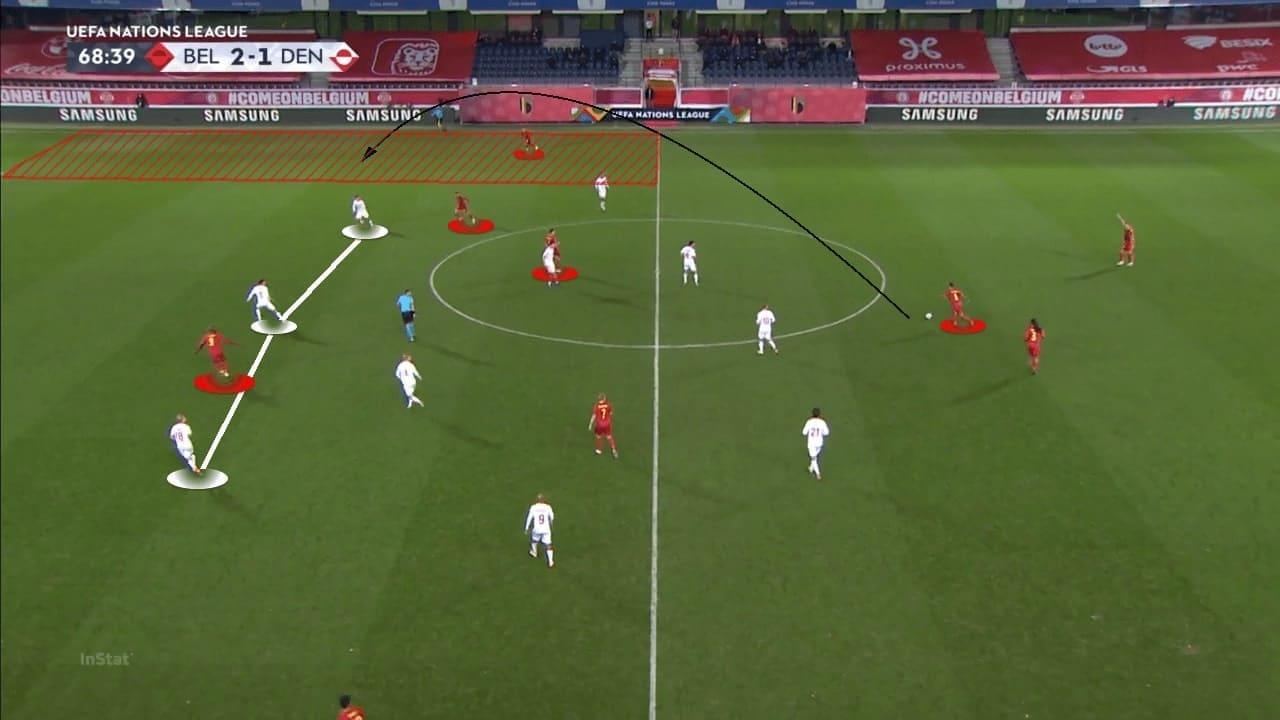
While the stats may show that Belgium like to play in a larger patient and possession-based style, they are not averse to a long, direct pass when needed to change the angle of attack or to get in behind the opposition’s defensive line. Again, having Alderweireld and Vertonghen in the side is a huge advantage in this regard, as they can easily play longer passes out of defence accurately.
The 3-4-2-1 shape allows Belgium’s wing-backs to stretch play by staying wide on the touchlines, which creates space as the opposition stays narrow to combat the sort of central overloads we described above. This example, taken from a game against Denmark, is the perfect example of this sort of situation – the Danish line is narrow and central due to the likes of Lukaku, Mertens and De Bruyne, which allows Alderweireld to play a long pass into space on the right flank for Thorgan Hazard to run onto. This allows the Red Devils to get into the final third with just one pass.
It is interesting to note that Belgium’s central midfielders do not have too much responsibility in terms of their build-up, especially on the ball. Their role is to create space and favourable situations through their positioning and movement.
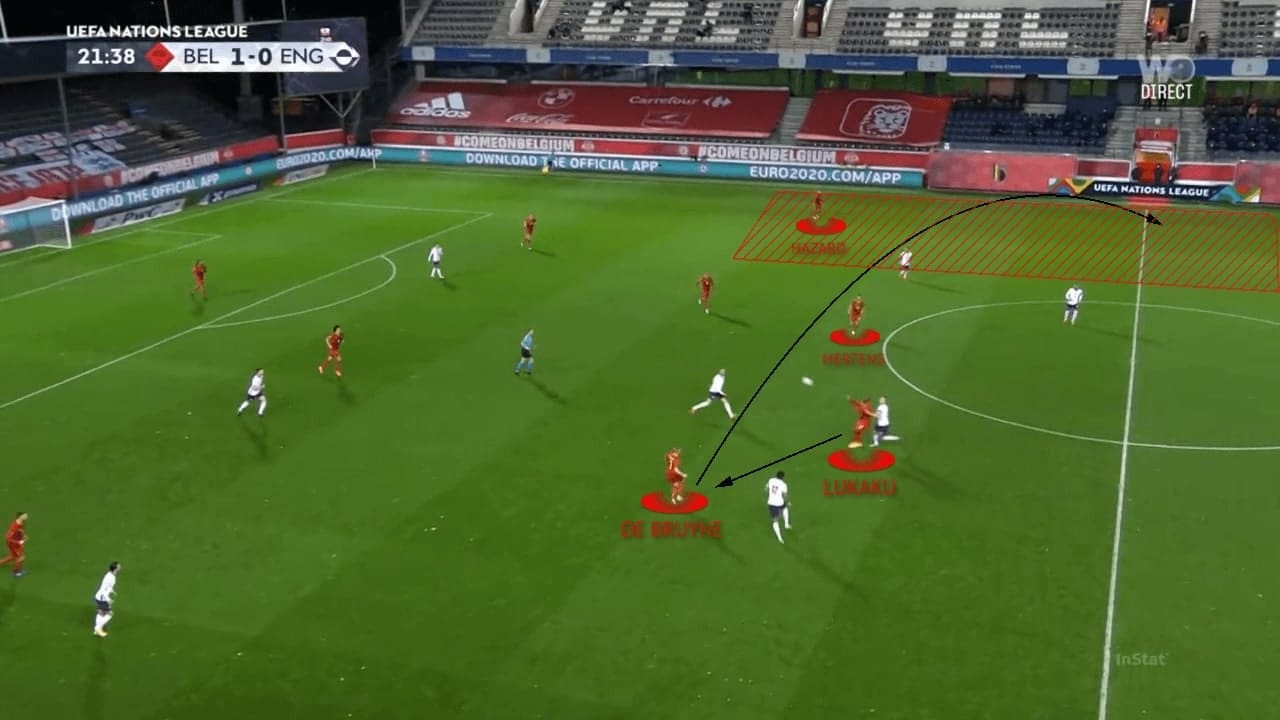
Belgium’s tactics often help them in creating opportunities against teams that play with a low block, while if they face a team that presses hard and high, they can utilise the aforementioned direct approach to bypass this press and enter the final third quickly.
Lukaku is also often used as a target man for direct passes from deep or wide, and he has the physical strength needed to hold the ball up and play in runners. This means that Belgium often have players making third-man runs off Lukaku, as he can find them with simple passes, as we can see in the above example.
Here, De Bruyne receives the lay-off from Lukaku and is then able to play a simple switch out wide to Thorgan Hazard, who has a lot of space to run into.
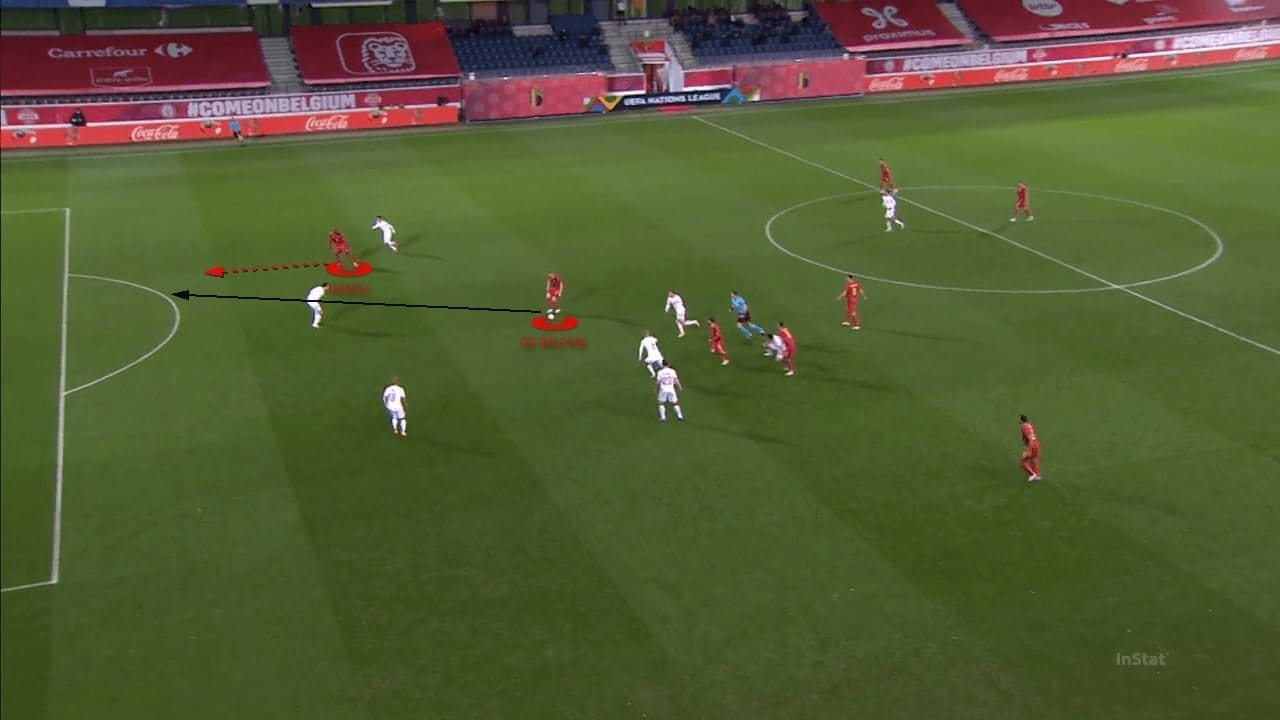
In the final third, Belgium look to make forward runs whenever possible to utilise the pace and ball-carrying ability of the likes of Lukaku, Hazard and Mertens, with possibly the best player in the world at supplying accurate through balls in De Bruyne behind them to create 1v1 situations in the penalty area.
This example shows the combination between Lukaku and De Bruyne, where the Manchester City man is able to receive in space and immediately send a defence-splitting pass for Lukaku to run onto and score.
Individual quality can play a big role at international tournaments, and with the likes of De Bruyne, Lukaku, Hazard and more in the squad, Belgium certainly have the players to decide the big moments on which matches can turn in knockout football.
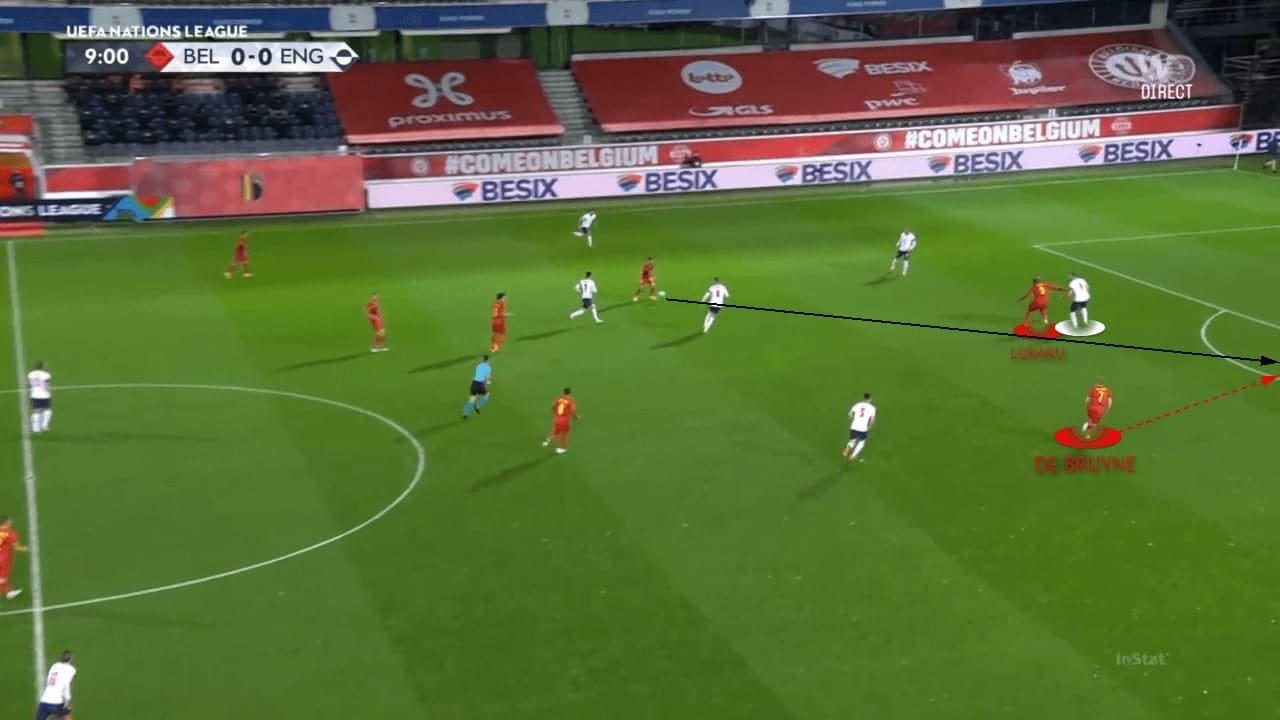
The final example to showcase Belgium’s offensive tactics is another combination between Lukaku and De Bruyne, where there is a reversal of roles from their usual duties – Lukaku turns creator and De Bruyne finishes the move off. Lukaku often drops off from the defensive line as a decoy, which draws out a centre-back and creates space for a runner from deep, as we can see with De Bruyne in the image.
These examples show the variety of attacking strategies that Belgium can use to create chances – they have a number of high-quality players in the squad who are versatile and can fulfill different roles at a high level, and this allows them to be unpredictable and dangerous in the final third.
DEFENSIVE PHASE
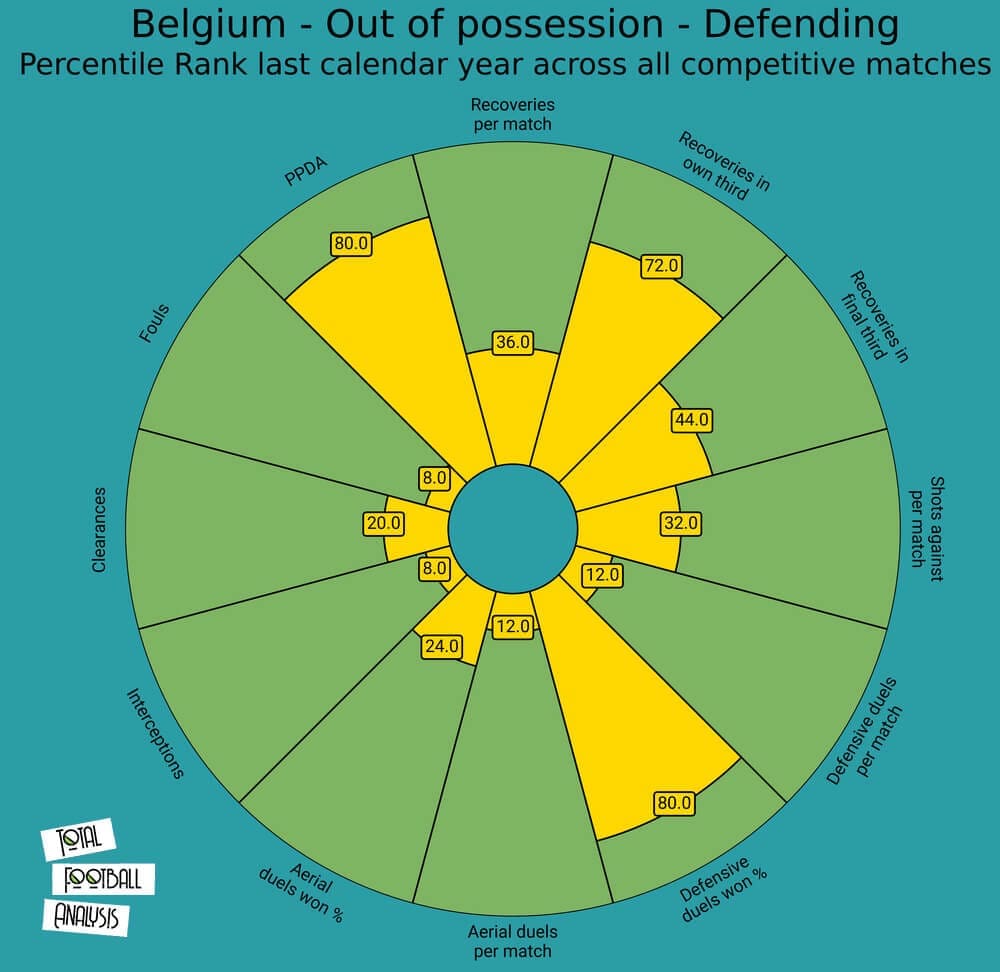
The earlier section has demonstrated how Belgium are a side that tend to dominate possession, which means that they spend a lot less time defending as well. The Red Devils are therefore likely to face teams that will try and use quick and direct attacks against them. Belgium’s percentile score for defensive duels won % (80) is impressive, and demonstrates a side that is able to win the ball back relatively frequently. However, they do not press intensely at all – their percentile rank for PPDA is 80, which indicates a higher PPDA and therefore a less intense press, and this is in line with the other defensive metrics that point towards a more passive and targeted defensive approach.
The other metrics tell us a lot about their defensive style – they are below average for recoveries in the final third (44), while impressive for recoveries in their own third (72). Belgium are not a side that presses too high, preferring to drop deep and allow the opposition to progress upfield. With defenders such as Alderweireld, Vertonghen, and Denayer, all of whom are comfortable in the air, they can easily defend the box from crosses, and their relatively passive approach can be seen through the low scores for a number of defensive metrics that measure the number of defensive actions – clearances (20), aerial duels (12), defensive duels (12) and interceptions (8).
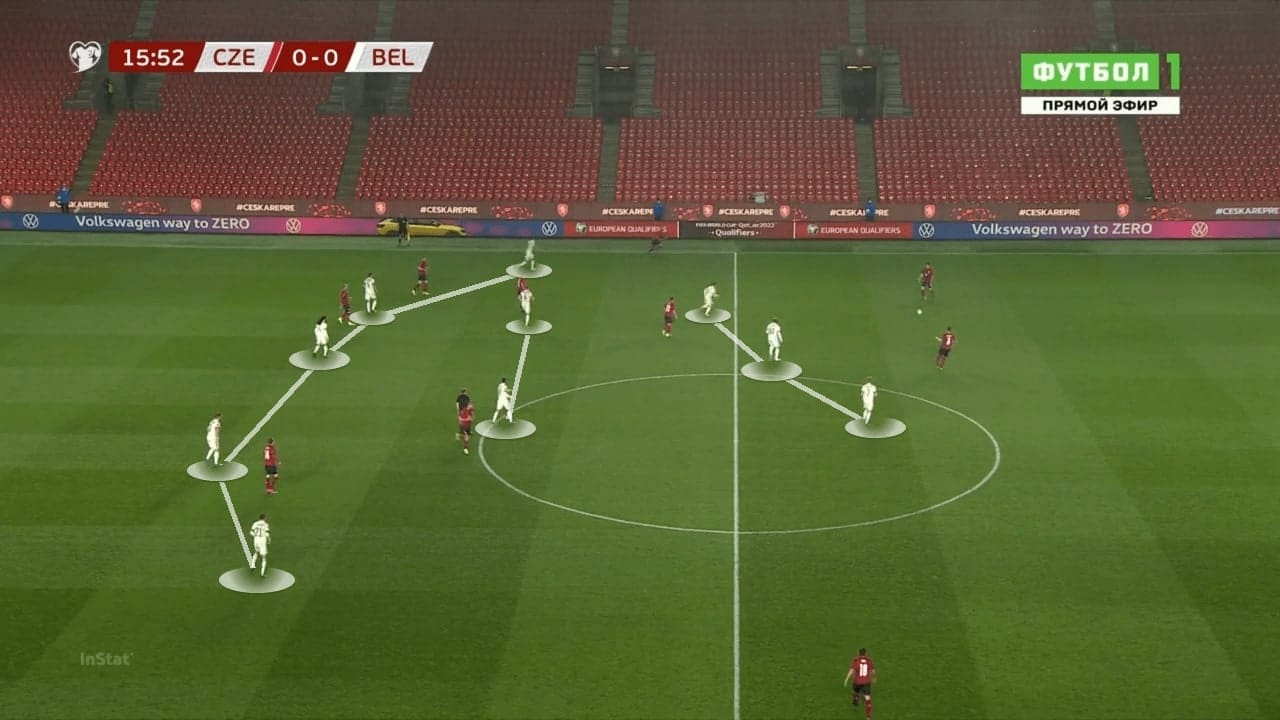
Belgium do not play with a high defensive line – rather, they set up in a mid-block with the defensive, midfield, and attacking lines in a compact block. The wing-backs drop back to create a back five, with two or three players in the midfield line, and the remainder forming the attacking line, as we can see in the example, where a 5-2-3 shape is being created off the ball.
This image also shows one of the pressing strategies and triggers used by the Red Devils. De Bruyne has stepped up and is the highest player for Belgium, as he is blocking the pass out to the left for the Czech Republic. This forces the play to the right, where we can already see how the Belgian players are ready to press, with the left wing-back also higher than his counterpart on the opposite flank to apply immediate pressure on the Czech right-back when he receives possession.
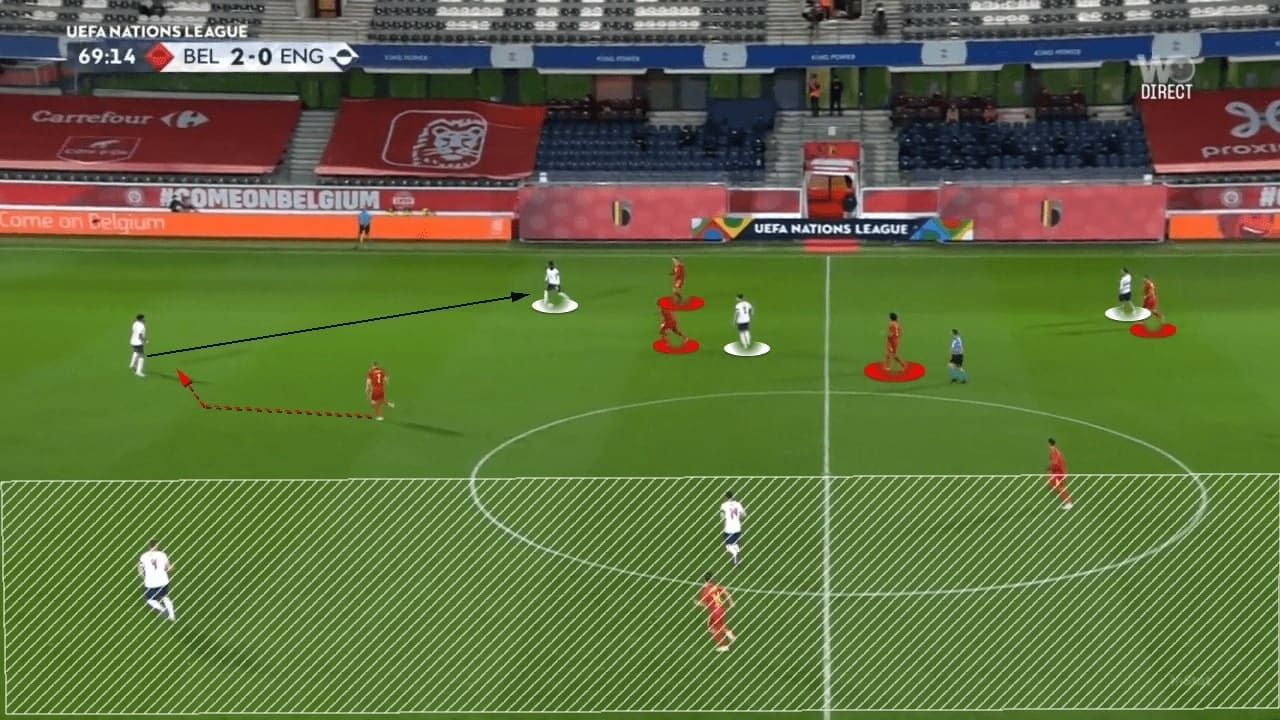
This is another example of a pressing trap used by Belgium. Here, De Bruyne once again forces the ball to the opposite side by curving his run from inside to press the England centre-back. This is a beneficial situation for Belgium, as it forces the ball wide into an area where they have numerical superiority and can win it back relatively easily, and they also have a 6v4 in this vertical half of the pitch, which is why De Bruyne forced the play out to that side in the first place.
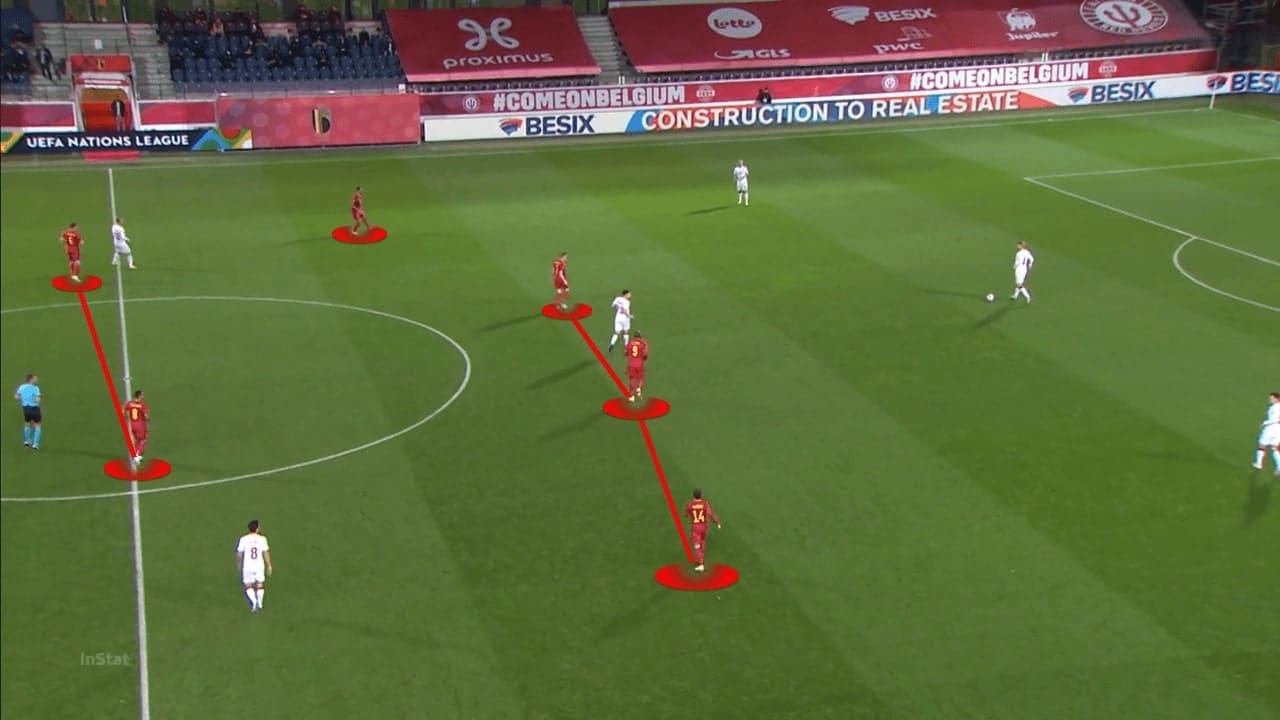
If Belgium are not looking to set up pressing traps, they settle into a central block aimed at forcing the opposition to go wide. The front five players try and ensure that all central passing options for the opposition centre-backs are marked and covered, with the front three also staying deep to ensure that the midfield pivot is not dragged out of position. Additionally, the wing-backs are given the freedom to press high if needed, with only one of them advancing at a time, which often converts Belgium into a 4-2-4 during the opponent’s first possession phase.
TRANSITIONS
With players like De Bruyne, Lukaku, Mertens, Hazard, and Carrasco, it is no surprise that Belgium are extremely dangerous from counter-attacking situations as well. They are able to spring forward from their relatively deep defensive block at pace, with the midfielders and De Bruyne capable of finding rampaging attackers in space.
The next image shows this sort of situation, where Lukaku is able to attract two English defenders towards him due to his sheer pace and power. This opens up the pass to Mertens for De Bruyne, and the Napoli forward is able to accelerate into the box in space as a result.
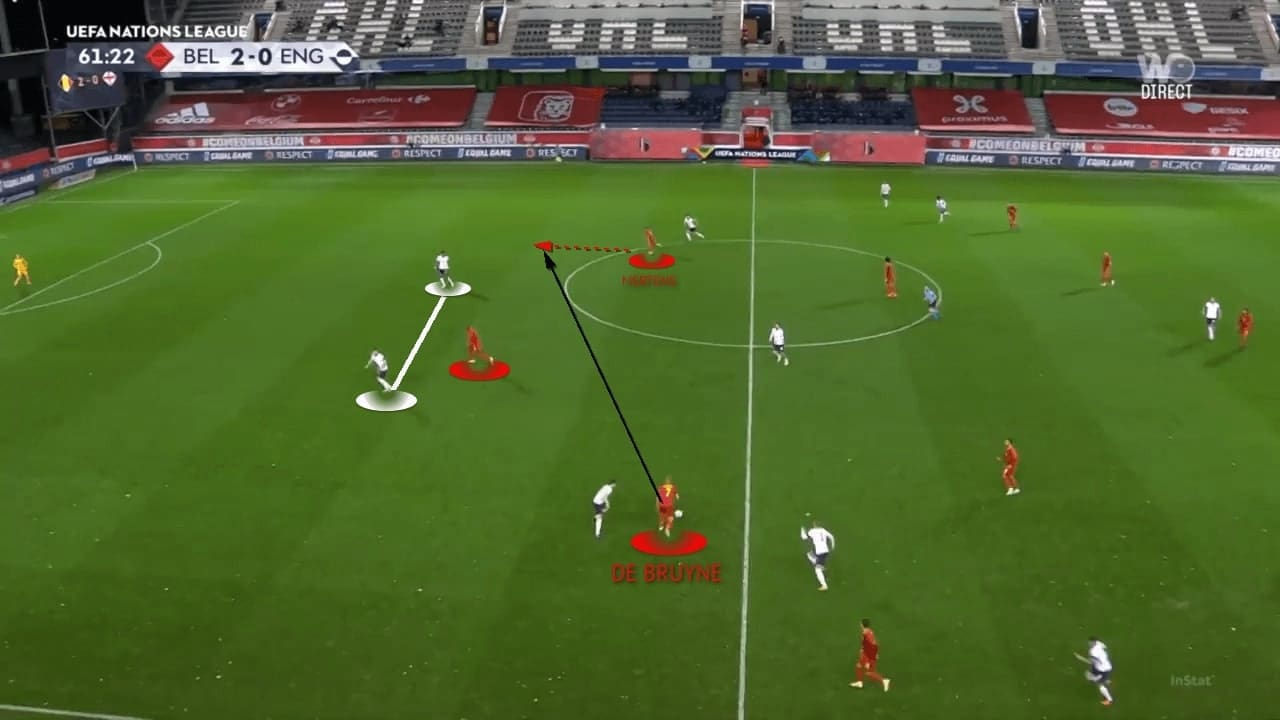
This is another reason why Belgium are quite happy to sit deep in a compact block when needed, as they have the players to thrive on the counter-attack. In fact, this is also a definite attacking strategy for the Red Devils, as they are able to draw the opposition high in this manner before being able to exploit that high defensive line through rapid counter-attacks.
In terms of defensive transition, we have already mentioned how Belgium look to get behind the ball in a compact shape as soon as possession is lost, so this minimizes the threat of leaving space for the opposition. They also rarely give the ball away in critical areas. However, one thing they do need to be careful about is the spacing behind their midfield line during defensive transitions.
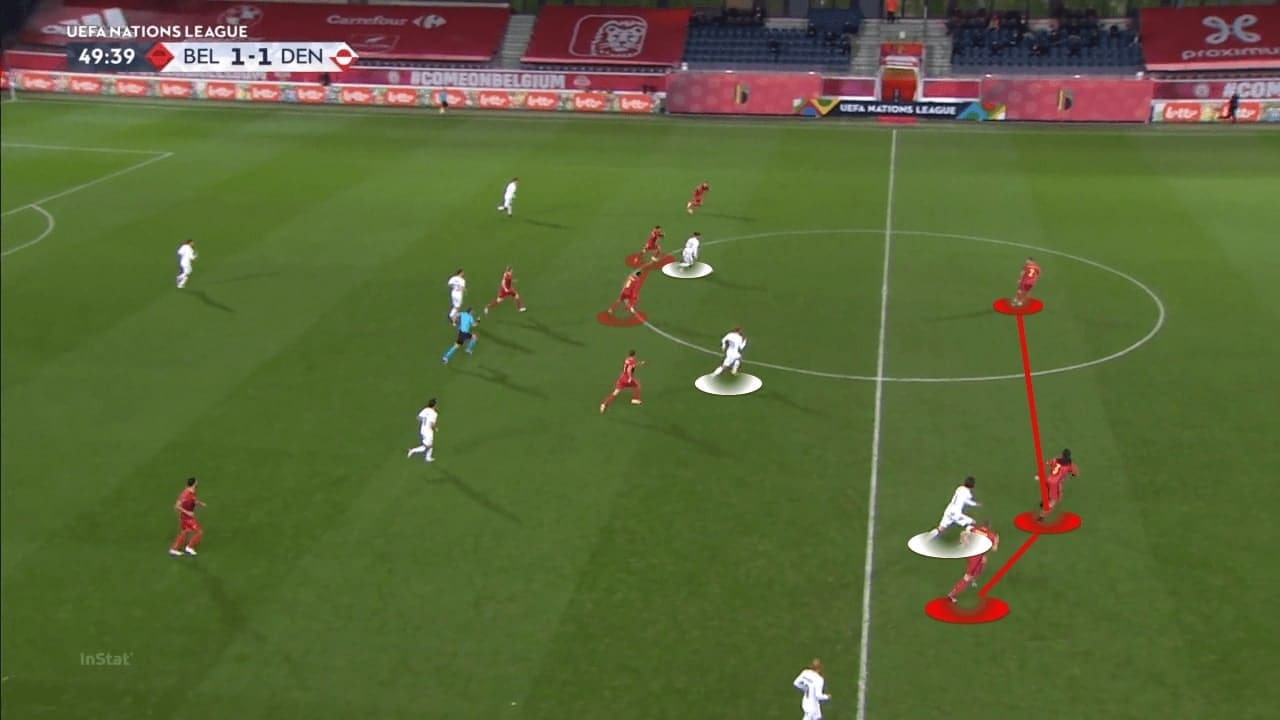
This image shows the situation immediately after Belgium lost possession in a central area. We can see how the midfield pivot is behind play, leaving the back three exposed, and Martinez may need to consider leaving one of the central midfielders or wing-backs in a deeper position to provide better protection against such situations.
FORWARDS
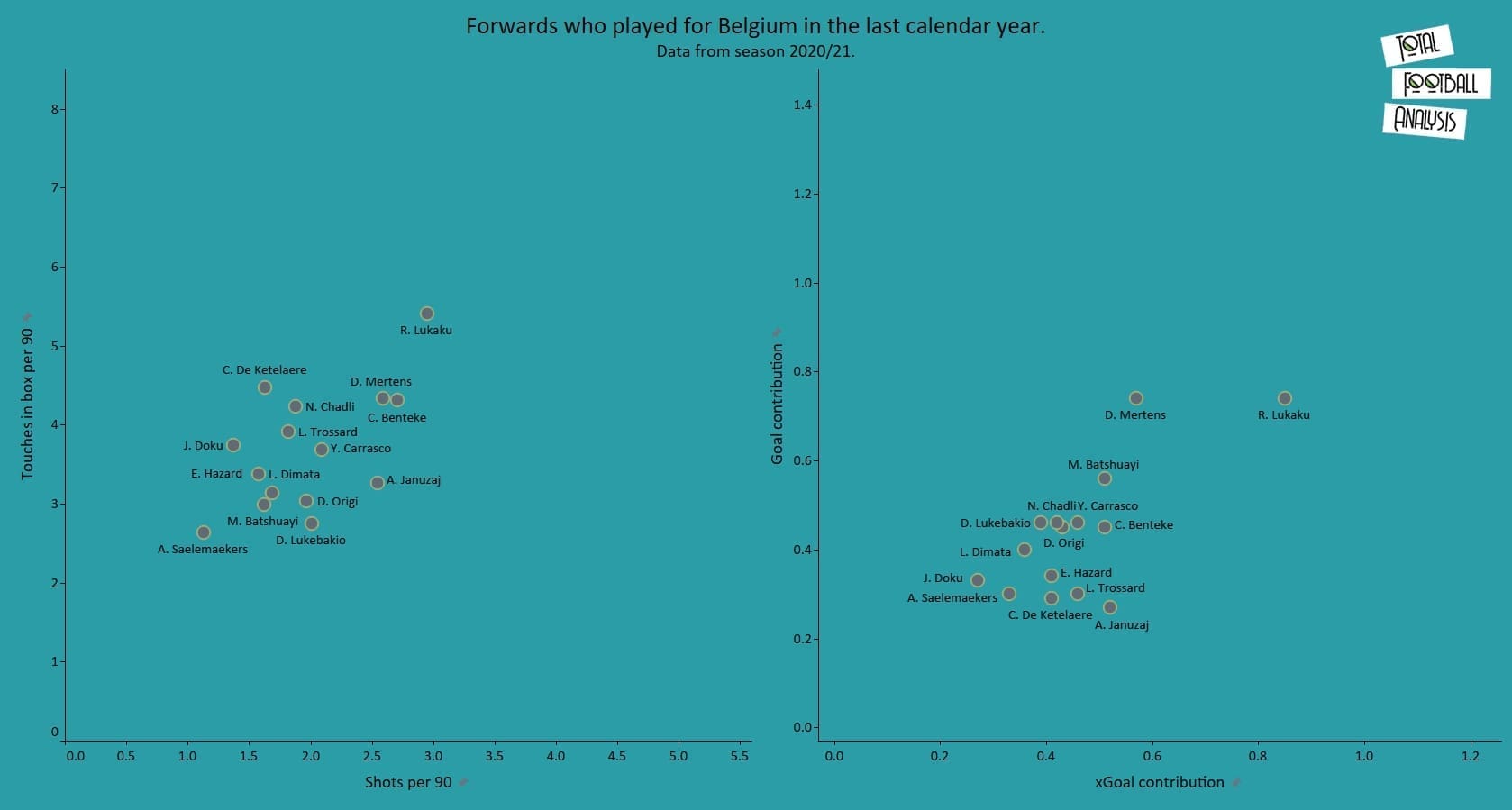
This scatter plot looks at the offensive stats of the Belgium squad for their clubs over this season, with players who have been called up to the squad in the last calendar year being considered. Romelu Lukaku stands out as one of the key attacking players, with the most touches and shots per 90 of any players in the squad, while Dries Mertens is also a threat in the box. It is also interesting to see how the likes of Chadli and Carrasco, who have played at wing-back for their clubs as well this season, are around the median for these stats, which underlines their attacking contributions and is also a clear indicator of the role they will play for Belgium as well.
Lukaku and Mertens are also excellent when we consider the second scatter plot, which looks at goal contributions versus expected goal contributions.
MIDFIELDERS
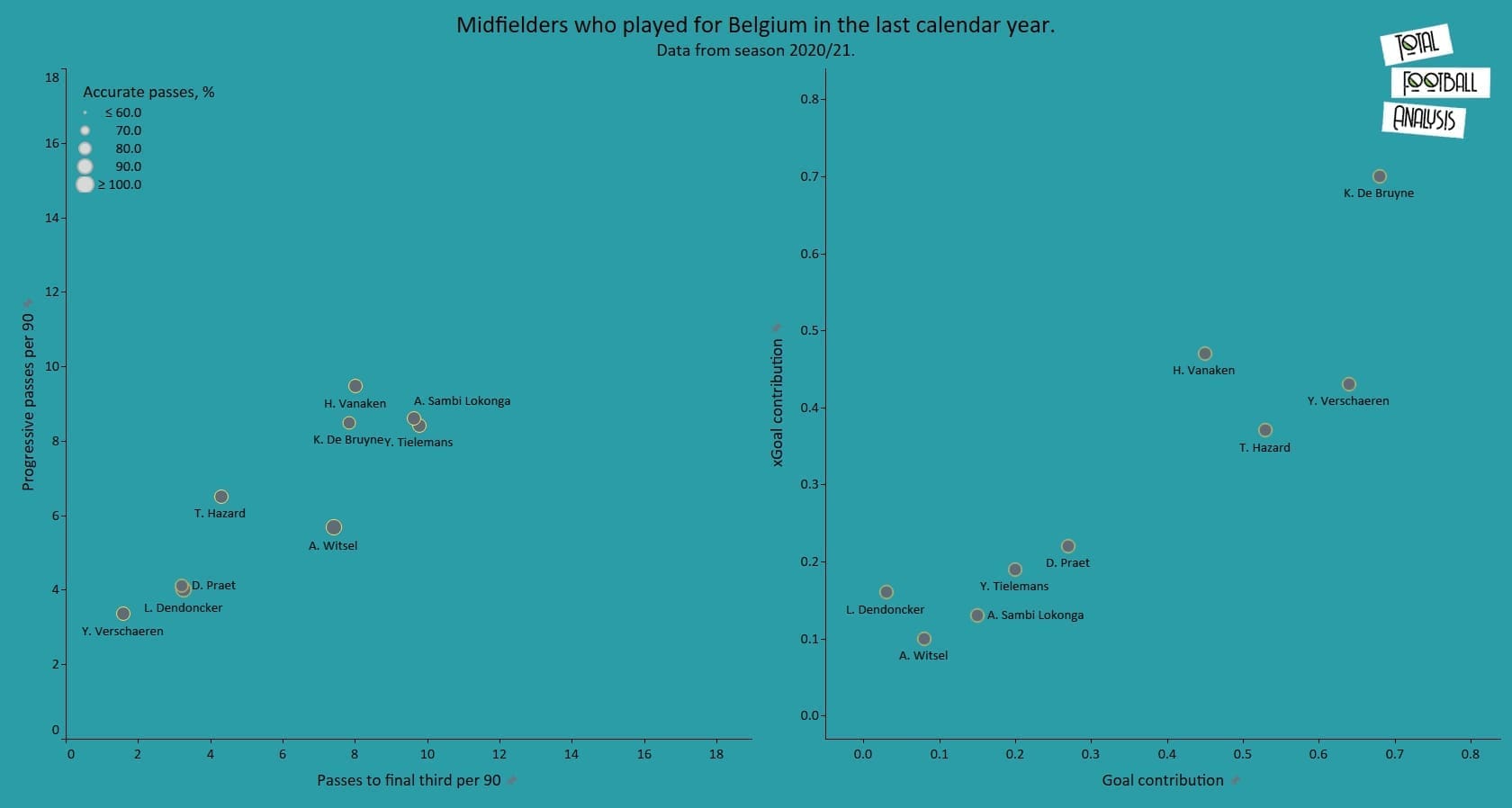
Here, we are looking at Belgium’s midfielders this season, with their ability to be a threat via their passing and goal threat. Kevin De Bruyne and Youri Tielemans are impressive when it comes to passes to the penalty area and passes to the final third, and also shows how De Bruyne does not necessarily have to be the creative hub for Belgium, as Tielemans is more than capable of providing that spark from midfield. However, it is quite obvious that the Manchester City man has been the biggest direct goal threat in terms of goals and assists when we look at the second scatter plot. The likes of Tielemans and Dendoncker will have to be a lot more defensively focused to give De Bruyne freedom in the final third, while it is also interesting that Thorgan Hazard, who is likely to be used at wing-back, is also a goal threat, having played in a similar role at Borussia Dortmund this season.
DEFENDERS
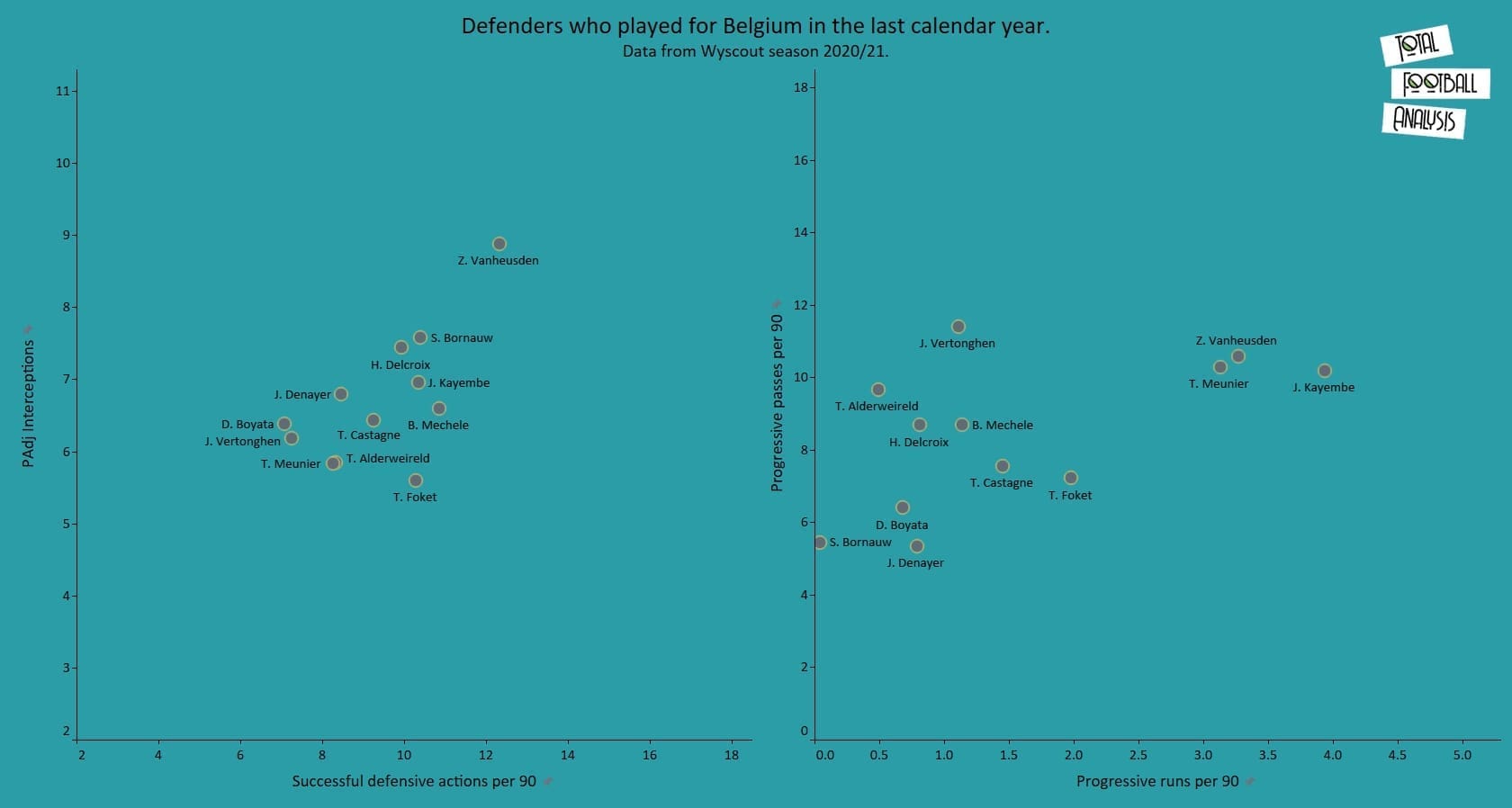
It is interesting that none of the expected starters for Belgium in defence rank too highly in these charts. Vertonghen, Alderweireld, and Denayer are all towards the bottom-left of the first chart, which tries to measure defensive proficiency. While this is heavily influenced by their respective club sides’ style of play, Martinez would be wise to try and ensure that they are not exposed to direct duels as much as possible.
The second chart is an indication of these players’ playmaking abilities, which is important for a team like Belgium which tries to monopolize possession. We can see how Vertonghen and Alderweireld are much better at progressing the ball than Denayer, and thus these two players will play much bigger roles in Belgium’s build-up play.
BEST PERFORMER
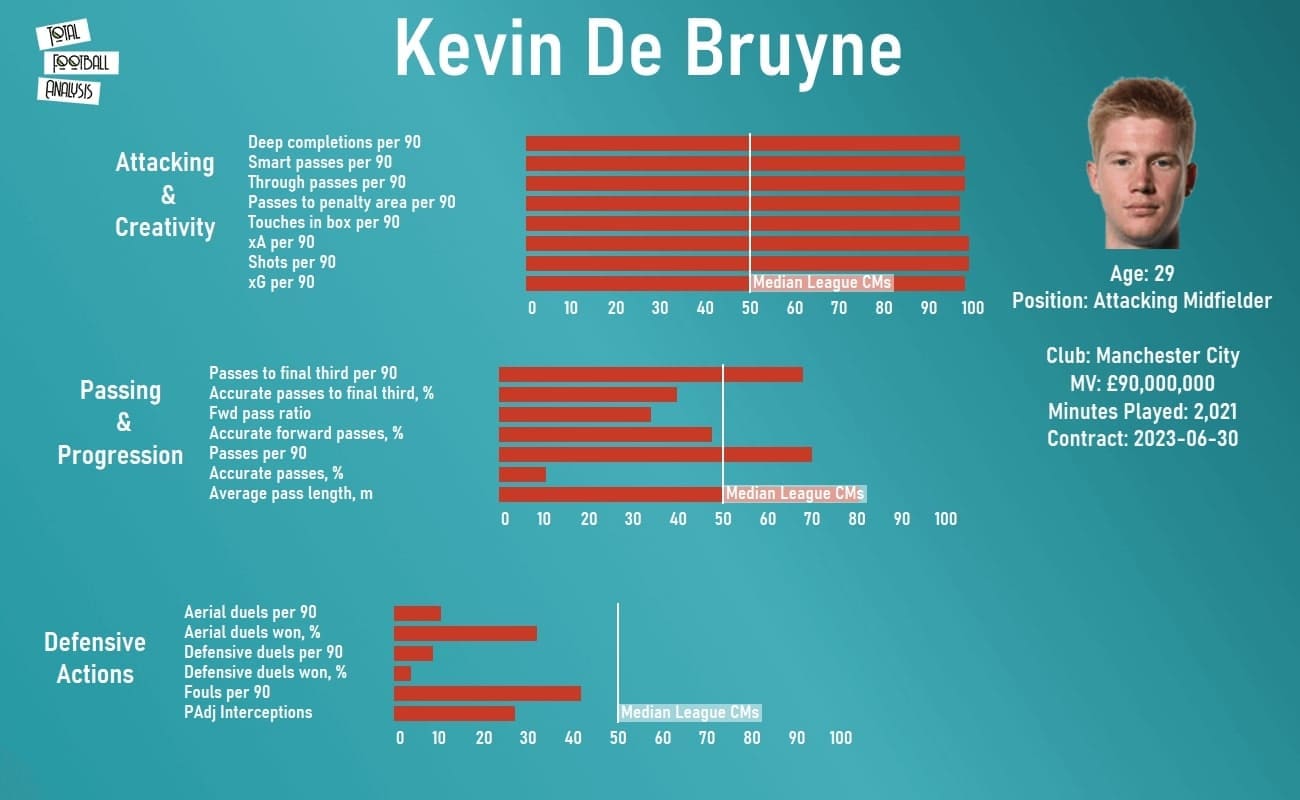
Kevin De Bruyne has stood out as an important player in almost every phase of the game in our analysis so far, and it is therefore fitting that he is considered as the most important player for the Belgium team. This is borne out by the statistics as well, which once again make it clear that he is one of the best players in Europe at the moment.
The profile shows how he is near the top for every attacking and creative metric this season, which underlines how he is capable of both scoring himself and setting up his teammates.
He has excellent stats when it comes to a couple of passing metrics as well – namely, passes to the final third per 90 and passes per 90. It is also interesting to see that he is well above the league median for pass length as well – De Bruyne is quite capable of playing longer and more direct passes, and this fits in well with Belgium, as he will often play passes out wide to switch the point of attack, or pass in a more direct manner during offensive transitions.
However, it is apparent that De Bruyne is not going to be a very efficient defensive player. Again, this works for Belgium, as we have already mentioned how they are relatively passive off the ball, while the 29-year-old has the intelligence to position himself well and direct the press, as he has shown on multiple occasions for Manchester City this season, as well as in our examples earlier.
A fit and firing De Bruyne will be key to Belgium’s hopes in this tournament, and he will be the player that opposition sides will have to try and subdue if they are to have any chance of defeating Belgium in this tournament.
PREDICTIONS FOR THE TOURNAMENT
Belgium are definitely one of the strongest contenders for EURO 2020, with an experienced and high-quality squad that has the ability to beat any team in the competition. The core of this side will be looking at the tournament as their last chance to win a trophy, with next year’s World Cup possibly coming too late for some of these players. The likes of Doku and Trossard could provide something different for Martinez off the bench, but this is largely a tried-and-tested squad, playing under a style and approach that they have become used to as we have shown in this scout report, and therefore Belgium should be a definite contender to pick up the trophy at Wembley on 11th July.
PREDICTED SQUAD LIST
Goalkeepers
Thibaut Courtois
Simon Mignolet
Matz Sels
Defenders
Toby Alderweireld
Dedyrck Boyata
Yannick Carrasco
Timothy Castagne
Nacer Chadli
Jason Denayer
Thorgan Hazard
Thomas Meunier
Thomas Vermaelen
Jan Vertonghen
Midfielders
Kevin De Bruyne
Leander Dendoncker
Dennis Praet
Youri Tielemans
Hanks Vanaken
Axek Witsel
Forwards
Michy Batshuayi
Christian Benteke
Jeremy Doku
Eden Hazard (C)
Romelu Lukaku
Dries Mertens
Leandro Trossard

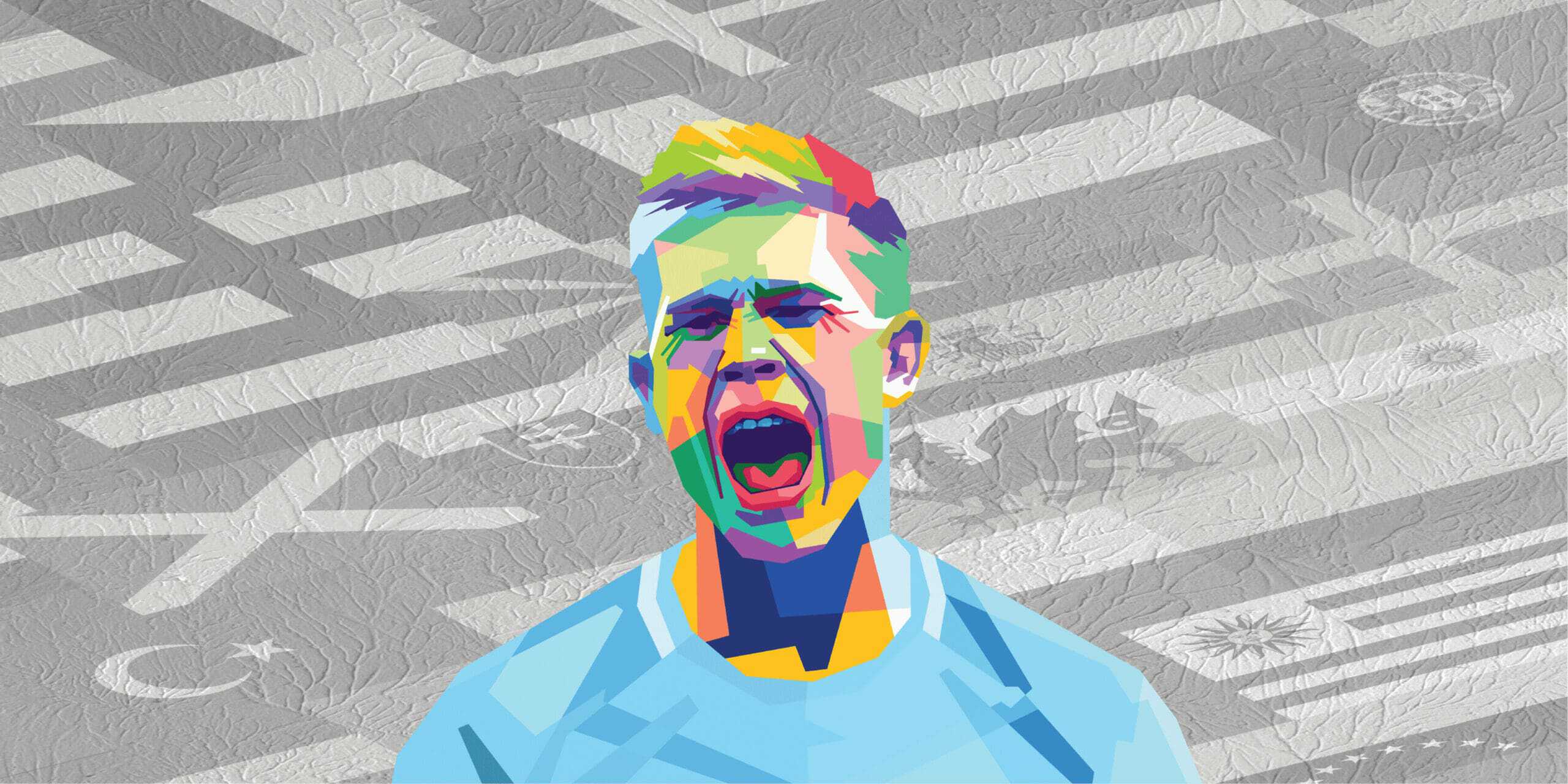



Comments